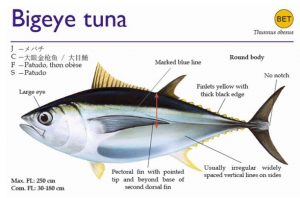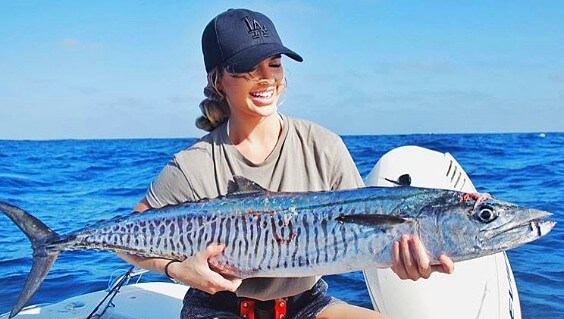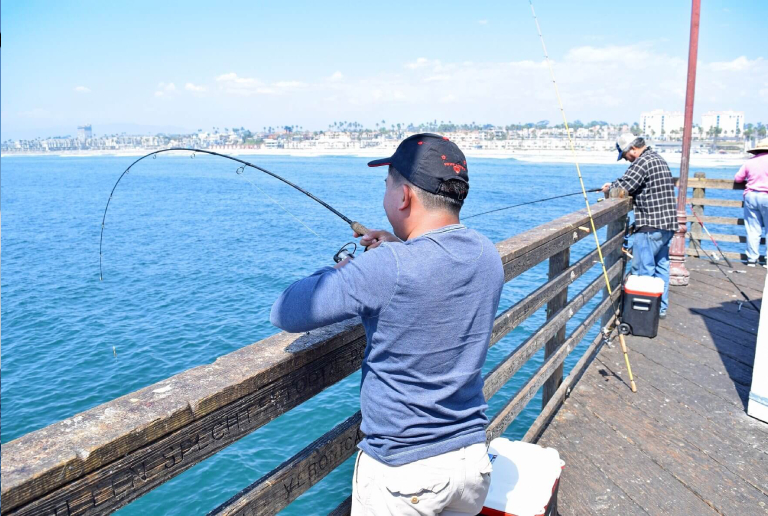
Bigeye Tuna Fishing Guide
Master bigeye tuna fishing with expert tips. Also try out tasty dish recommendations like bigeye tuna sushi and grilled bigeye tuna. Get ready for a perfect day on the water and in the kitchen.

Bigeye tuna, also known as Thunnus obesus, looks similar to the bluefin tuna but this species is slightly smaller. Its pectoral fin is about the same length as that of a yellowfin tuna. The first giveaway of a bigeye tuna that is its large pupil, which is twice times larger than the two species. This type of tuna tends to have a higher concentration of cholesterol compared to other tuna. They are often used to make sushi and sashimi in Japanese restaurants.
| Bigeye Tuna Info Bigeye Tuna Scientific Name – Thunnus obesus Bigeye Tuna Local Name – Ahi Bigeye Tuna Size – 2 to 5 feet Bigeye Tuna Mercury – Low Bigeye Tuna Price – Medium to High |
Bigeye are reported to live up to 12 years and reach a maximum length of about 5’5 feet, and a maximum weight in excess of 400 pounds. The current all tackle world record is 392 pounds.
BigEye Tuna vs Yellowfin Tuna
Yellowfin tuna and Bigeye Tuna are very similar and often get mixed up, especially if you catch one in the 100 pound range. Both have metallic blue/black back with a bright gold yellow side bands. One of the easiest ways to separate them is via the tail fin. The characteristics yellowfin tails are yellow/golden, while bigeye tails are darker in color, being purplish/black. In addition bigeye’s second dorsal and anal fin never grows as long as those of the yellowfin do.
Bigeye spend a majority of their day at depths greater than 250 feet, often diving as deep as 1,500 to 1,600 feet in search of forage. This is in contrast to the yellowfin tuna, which spends over 75 percent of its time less than 250 feet from the surface.
When it comes to taste and texture, bigeye has a rich, meaty flavor with a higher fat content. This makes it better for sushi and sashimi. Yellowfin has a lighter, milder flavor and a firmer texture, making it more suited for grilling and searing. For cooking bigeye is versatile working well both raw and cooked. Yellowfin’s leaner meat is best when cooked being grilled, seared, or used in poke bowls.
Bigeye Tuna Fishing Tips
Are you ready to reel in the bigeye? Bigeye tuna fishing can be a thrilling experience for experienced anglers or beginners. These powerful fish are found in deep waters, offering a tough fight for those daring to take them on.
Bigeye Tuna Habitat
Bigeye tuna can be found in warm temperate waters of the Atlantic, Pacific, and Indian Oceans. Schools of bigeye tuna tend to be found deep during the day whereas schools of bluefin, yellowfin, and other tuna species are known to swim more toward at the surface.
Bigeye has a habit of hunting for baitfish at high flyers or canyons so you should take your boat to these places to have a better chance of catching them. The best time to catch them is around the twilight or shortly after the dark. You will also get good result when hunting them just before dawn. When hunting in the dim condition, dark color baits will work better.
When looking for bigeye, you must look out for signs like birds and porpoises as they can tell you where the bait fish are. If you spot feeding birds or porpoises, chances are the bigeye will also be nearby. Pilot whales and bigeye are often seen feeding together on the same school of squid below the ocean surface. Therefore, if you notice a pilot whale, it could be that the bigeye is within a proximity range.
Tuna Fishing Tips
Spreader bars technique can be used to attract the tuna to the top of the water during the day time. You can use the spreader bar technique along with green and yellow shell squids lures. A combination of jigs that weigh 180 – 250 gm will also help to lure the fish to the top water. Bigeye has good eyesight and using thin fluorocarbon fishing line can prevent them from seeing the hook. There are some hooks that are painted red in color to camouflage the blood of bleeding bait fish.
When trolling for bigeye tuna, you should maintain a speed of 6 – 8 knots along the 100 fathom line. On the day you go out fishing, the water temperature should be warm around 70 degrees (21 deg C) . The best time to go fishing for Bigeye tuna is May through October in the mid Atlantic sea. Bigeyes are tougher so they require professional fishing skills. A fishing charter that is longer than 25 feet will work the best.
The bite is unmistakable and unforgettable. The water erupts with bomb like explosion, you may need a new pair of trousers! Unlike other tuna species that come up underneath the bait and snatch it, bigeye tuna leave a huge hole in the ocean when they explode on the bait. They often travel in small packs and multiple hook-ups are common, resulting in two or three rods doubling over, leaving anglers with their mouths open and their hands full.
Spreader Bar Fishing Items
Bigeye Tuna Bait
The diet of the bigeye tuna includes squid, crustaceans, mullet, sardines, and small mackerels. Different types of baits can be used in bigeye tuna fishing including rigged mullet, sea star, rigged squid, ballyhoo with lender, and braid bigeye rocket. To hook the lure, you can use a 11/0 hook. Often, more than one tuna will end up at the hook of your fishing rods as they are used to travel in small schools. Fishing methods include trolling deep with squid, mullet, other small baits, and artificial lures. You can also live bait fish in deep waters with similar baits.
Always keep an eye out for whales, which are often found in close proximity to bigeye tuna schools. Anglers believe that bigeye and the whales feed on the same squid down deep below and this is why they are often seen together.
Bigeye Tuna Lures
As mentioned above, the Spreader bars technique will give the ideal chance to drag several lures enticing bigeye tuna. One standout lure for this fish is Braid Big Eye Rocket Lures.
Braid Big Eye Rocket
Braid Big Eye Rocket lures are a proven producer worldwide. The Braid Big Eye Rocket swims with a natural squid-like appearance, leaving a thin bubble trail that draws fish right to the lure. Great bait for flat line or center line trolling. A bigeye tuna killer for sure, this lure has become an absolute must for serious fishermen looking to capitalize on trophy yellowfin, bigeye, and even the prized wahoo!
The 9″ is the most popular size for most situations and is the go to size for most fishing folk. The demand for a slightly longer, heavier version for rougher waters and to mimic larger baits resulted in the senior braid big eye rocket 11″ version.
Buy yours today!
Bigeye Tuna Fishing FAQ
What are the best fishing techniques for catching bigeye tuna?
Bigeye tuna are often caught using trolling techniques with lures or bait, deep dropping, and chunking. Pay attention to water temperature and current patterns, as bigeye tuna prefer specific conditions.
What bait are most effective for bigeye tuna?
Bigeye tuna are attracted to a variety of bait, including squid, flying fish, and smaller fish like mackerel or sardines. Using fresh bait is key to enticing these elusive fish.
What gear is recommended for targeting bigeye tuna?
For bigeye tuna, it is essential to use heavy duty fishing gear capable of handling large fish. This includes robust rods and reels, strong fishing line (typically between 50-130 lb test), and sturdy hooks and leaders to withstand the fight.
What depths are bigeye tuna typically found at?
Bigeye tuna are known to inhabit deep waters, often ranging from 150 to 500 meters deep. However, they may come closer to the surface during feeding times, especially at night.
What are the best times of day to catch bigeye tuna?
Bigeye tuna are most active during low light conditions, such as dawn, dusk, and nighttime. Anglers often have success targeting them during these periods when they are actively feeding.
What regions are bigeye tuna most abundant?
Bigeye tuna are found in both tropical and temperate waters worldwide. However, they are often abundant in areas with underwater structures like seamounts, ridges, and drop-offs, as these provide ideal hunting grounds.
Bigeye Tuna Dish to Try
Once you have caught your bigeye tuna, turn that fresh catch into a mouthwatering meal. From sushi to grilled dishes, bigeye tuna offers versatility and flavor that is hard to beat. Lets explore the best recipes to make the most of your catch.
Tuna Health Benefits
High in Omega-3s great for heart health and reducing inflammation.
Protein Packed Tuna is a great lean protein choice.
Low in Calories a healthy option for those watching their weight.
Vitamins & Minerals nutritional benefits like Vitamin D, B12, and selenium.
Bigeye Tuna Sushi Recipe
For a delicious bigeye tuna sushi recipe, you will need just a few key ingredients. Of course you will need some fresh bigeye tuna. You will also need sushi rice, nori (seaweed sheets), and a bit of wasabi.
To make perfect sushi, start by preparing the sushi rice. When it is cooked and cooled, season it with rice vinegar, sugar, and salt. The next step is to slice your bigeye tuna into thin, even slices for sashimi. Use a sharp knife to achieve clean cuts. Lay a sheet of nori on your bamboo mat, spread a thin layer of rice, and top with the tuna slices. Roll it up tightly and slice into bite sized pieces.
For presentation, arrange the sushi neatly on a plate, garnishing with wasabi and pickled ginger for that pro look.
- Bigeye Tuna Sushi Ingredients: Fresh bigeye tuna, sushi rice, nori, wasabi
Grilled Bluefin Tuna Recipe
One of the best ways to eat Bigeye Tuna is to grill it. For mouthwatering grilled bluefin tuna recipe, you will need fresh tuna steaks, olive oil, garlic, lemon, and your favorite herbs.
Start by brushing the tuna with olive oil and seasoning it with minced garlic, lemon juice, and herbs like thyme or rosemary. Preheat your grill to high heat, aiming for about 500°F (260°C). Sear the steaks for 2–3 minutes on each side to get perfect grill marks while keeping the center tender.
Serve your grilled tuna with a light, fresh salad or a side of fluffy rice for a balanced meal.
For extra flavor try marinating the tuna in a mix of soy sauce, ginger, and sesame oil for about 30 minutes before grilling. It adds a zesty kick that pairs beautifully with the rich tuna.
- Grilled Bluefin Tuna Ingredients: Tuna steaks, olive oil, garlic, lemon, and herbs
Bigeye Tuna Poke Bowl
Creating a delicious bigeye tuna poke bowl at home is both simple and refreshing. Start with diced bigeye tuna flesh. Marinate it in a mix of soy sauce and sesame oil for added flavor.
To build a poke bowl, layer your choice of base. Examples include sushi rice or mixed greens. Top it with the marinated tuna. Add a variety of fresh vegetables such as cucumber, radish, and edamame for crunch and color. For customization, get creative with toppings. Creamy avocado, crispy seaweed, and tangy pickled ginger all make excellent additions. Finish it off with a sprinkle of sesame seeds or sliced scallions to elevate your poke bowl to the next level.
Enjoy this vibrant dish that is as pleasing to the eye as it is to the palate.
- Bigeye Tuna Poke Bowl Ingredients: Diced tuna, soy sauce, sesame oil, and vegetables
Stay tuned for more tips and tricks on How To Catch Tuna.
Keywords
- bigeye tuna fishing techniques
- best time for bigeye tuna
- deep-sea fishing for tuna
- how to catch bigeye tuna
- tuna fishing gear
- tuna sushi recipe
- fresh bigeye tuna sushi
- bluefin tuna vs bigeye tuna
- grilling bluefin tuna
- tuna fishing season
- tuna fishing tips
- bigeye tuna vs yellowfin
- chumming for tuna
- trolling for tuna
- bigeye tuna marinade
- preparing tuna steaks
- tuna poke bowl recipe
- best tuna for sushi
- tuna nutrition facts
- sustainable tuna fishing
 Rigged Trolling Flexi Spreader Bar Topwater
Rigged Trolling Flexi Spreader Bar Topwater 36″ Skipjack Hybrid UV 8″ Blue & Pink Mackerel Baits
36″ Skipjack Hybrid UV 8″ Blue & Pink Mackerel Baits Mini Spreader Bar
Mini Spreader Bar Big Eye Rocket 9″
Big Eye Rocket 9″ Penn Tuna Fishing Rod & Reel Combo
Penn Tuna Fishing Rod & Reel Combo View Best Tuna Fishing Lures
View Best Tuna Fishing Lures
 Tuna Fishing Book
Tuna Fishing Book

 Fishing Pliers and Knife Combo
Fishing Pliers and Knife Combo Stainless Steel Fishing Leaders
Stainless Steel Fishing Leaders Saltwater Trolling Lure for Tuna
Saltwater Trolling Lure for Tuna